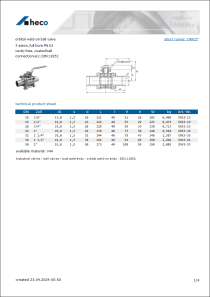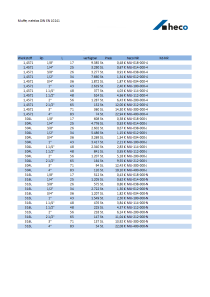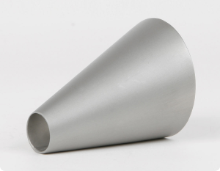
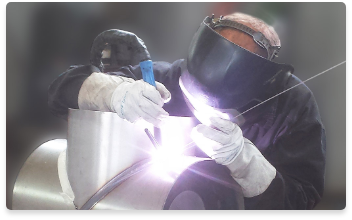

- Butt welding fittings
- bends
- T- X- Y- pieces
- T- and Y-bends
- reducers
- caps and heads
- collars
- branch saddles
- orbital fittings
- ANSI / ASME
- Industrial valves
- ball valves
- actuators
- drain cocks
- gate valves
- globe valves
- non-return valves
- Y-strainers
- control technology
- Flanges
- welding neck flanges
- threaded flanges
- blind flanges
- plate flanges
- loose plate flanges
- collars
- flange-fittings
- ANSI/ ASME
- other
- Systems
- TEEKAY
- Victaulic
- press fittings
- quick couplings
- clamp connections
- cutting rings
- DIN 11864/ DIN 11853
- railing construction
- Beverage fittings
- unions
- fittings
- pipe clamps
- Tri-Clamp
- valves & cocks
- flange connections
- inspection glasses
- filter & strainers
- spray balls

orbital weld-on ball valveORK3
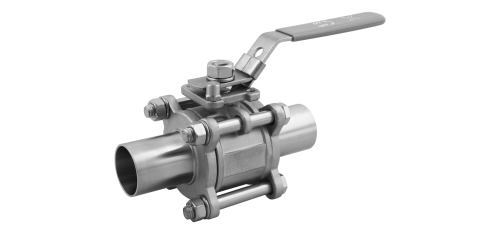



orbital weld-on ball valve 3-piece, full bore PN 63 cavity free, coated ball connection acc. DIN 11852
PART LIST
| No. | Designation | Material |
|---|---|---|
| 1. | Housing | V4A (CF8M/ 1.4408) |
| 2. | Ball* | V4A (CF8M/ 1.4408) |
| 3. | Control shaft | V4A (CF8M/ 1.4408) |
| 4. | Tensioning screw | V4A (CF8M/ 1.4408) |
| 5. | Seat seal (2x) | PTFE |
| 6. | Stem packing seal | PTFE |
| 7. | Shaft seal | PTFE |
| 8. | Housing seal (2x) | PTFE |
| 9. | Handle | V2A (AISI 304) |
| 10. | Hand sleeve | PVC (blue) |
| 11. | Stop | V2A (AISI 304) |
| 12. | Flange (2x)* | V4A (CF8M/ 1.4408) |
| 13. | Hexagon head screw (4x) | V2A (AISI 304) |
| 14. | Lock washer (4x) | V2A (AISI 304) |
| 15. | Hex-head nut (4x) | V2A (AISI 304) |
| 16. | Retaining disk | V2A (AISI 304) |
| 17. | Hex-head nut | V2A (AISI 304) |
| 19. | Locking device | V2A (AISI 304) |
* Surface roughness of the polished inner surfaces ra <= 0,8µm
ISO top flange plate according to ISO 5211
for mounting directly on actuator
| DN | ISO | a | b | z | y | x |
|---|---|---|---|---|---|---|
| 10 | F03 | 25.5 | 37 | 5 | 9.5 | 5/16x24 |
| 16 | F03 | 25.5 | 37 | 5 | 13 | M8x1.25 |
| 20 | F03 | 25.5 | 37 | 5 | 13 | M8x1.25 |
| 26 | F04 | 29.7 | 42 | 6.5 | 14 | 7/16x14 |
| 32 | F04 | 29.7 | 42 | 6.5 | 14 | 7/16x14 |
| 38 | F05 | 35.4 | 50 | 8.5 | 17.5 | M12x1.75 |
| 50 | F05 | 35.4 | 50 | 8.5 | 17.5 | M12x1.75 |
Installation
Before welding the ends of the connections, the middle section of the ball valve must be disassembled
to prevent damaging the seals.
1. Clamp the valve carefully in a vise. You can prevent damage
to the ends of the housing using protective wedges.
Unscrew the hex-head nuts crosswise and pull the screws out of the housing.
Remove the middle section of the ball valve. Make sure that the seals and the ball do not
fall out of the housing. Place the parts aside with care. You should mark the ends in order
to be able to determine which ends are for connection later during reassembly.
2. Mount a piece of tube with a length equal to that of the middle section between the ends of the connections.
3. Allow the ends of the connections to cool off adequately before you install the middle section.
Remove the piece of tube mentioned above.
Push the middle section of the ball valve between the ends of the connection. If necessary, orient the middle
section so it attaches to the corresponding ends of the connection.
Make sure that all seals are seated properly and that there is no dirt or contamination on the
seals or the ball.
Push the hex-head screw through the holes in the ends of the connection. Tighten the nuts evenly
by tightening them crosswise. Note the maximum torque of the screws when tightening.
Test the function of the ball valve. Test all connections to ensure they do not leak.
Maintenance and Inspection
The ball valves are maintenance-free under normal operating and ambient conditions.
However, the following inspections should be performed at regular intervals depending
on the frequency of activation and the operating conditions:
> Testing the spindle seal for leaks
If the seal is failing, then the stem packing must be tightened at operating pressure.
Tighten the nut until the spindle seal is tight again and does not leak any more.
Make sure that the ball valve is still easy to operate.
> Testing the ball seal for leaks
If the seal is not tight enough, the ball and/or the seal set of the ball valve can be replaced.
For 3-part ball valves, you only need to remove the middle part of the ball valve.
You absolutely must follow our installation and operating instructions!
See www.heco.de/Downloads/Anleitungen
connection acc. DIN 11852
extended product description
| dimension | File Download (3D-PDF) | File Download (STEP) |
|---|---|---|
| DN 10/ 3/8" | heco_ORK3-13.pdf | heco_ORK3-13.step |
| DN 16/ 1/2" | heco_ORK3-19.pdf | heco_ORK3-19.step |
| DN 20/ 3/4" | heco_ORK3-23.pdf | heco_ORK3-23.step |
| DN 26/ 1" | heco_ORK3-29.pdf | heco_ORK3-29.step |
| DN 32/ 1 1/4" | heco_ORK3-35.pdf | heco_ORK3-35.step |
| DN 38/ 1 1/2" | heco_ORK3-41.pdf | heco_ORK3-41.step |
| DN 50/ 2" | heco_ORK3-53.pdf | heco_ORK3-53.step |
Stainless steel valves & cocks cocks orbital
orbital weld-on ball valveORK3

PART LIST
| No. | Designation | Material |
|---|---|---|
| 1. | Housing | V4A (CF8M/ 1.4408) |
| 2. | Ball* | V4A (CF8M/ 1.4408) |
| 3. | Control shaft | V4A (CF8M/ 1.4408) |
| 4. | Tensioning screw | V4A (CF8M/ 1.4408) |
| 5. | Seat seal (2x) | PTFE |
| 6. | Stem packing seal | PTFE |
| 7. | Shaft seal | PTFE |
| 8. | Housing seal (2x) | PTFE |
| 9. | Handle | V2A (AISI 304) |
| 10. | Hand sleeve | PVC (blue) |
| 11. | Stop | V2A (AISI 304) |
| 12. | Flange (2x)* | V4A (CF8M/ 1.4408) |
| 13. | Hexagon head screw (4x) | V2A (AISI 304) |
| 14. | Lock washer (4x) | V2A (AISI 304) |
| 15. | Hex-head nut (4x) | V2A (AISI 304) |
| 16. | Retaining disk | V2A (AISI 304) |
| 17. | Hex-head nut | V2A (AISI 304) |
| 19. | Locking device | V2A (AISI 304) |
* Surface roughness of the polished inner surfaces ra <= 0,8µm
ISO top flange plate according to ISO 5211
for mounting directly on actuator
| DN | ISO | a | b | z | y | x |
|---|---|---|---|---|---|---|
| 10 | F03 | 25.5 | 37 | 5 | 9.5 | 5/16x24 |
| 16 | F03 | 25.5 | 37 | 5 | 13 | M8x1.25 |
| 20 | F03 | 25.5 | 37 | 5 | 13 | M8x1.25 |
| 26 | F04 | 29.7 | 42 | 6.5 | 14 | 7/16x14 |
| 32 | F04 | 29.7 | 42 | 6.5 | 14 | 7/16x14 |
| 38 | F05 | 35.4 | 50 | 8.5 | 17.5 | M12x1.75 |
| 50 | F05 | 35.4 | 50 | 8.5 | 17.5 | M12x1.75 |
Installation
Before welding the ends of the connections, the middle section of the ball valve must be disassembled
to prevent damaging the seals.
1. Clamp the valve carefully in a vise. You can prevent damage
to the ends of the housing using protective wedges.
Unscrew the hex-head nuts crosswise and pull the screws out of the housing.
Remove the middle section of the ball valve. Make sure that the seals and the ball do not
fall out of the housing. Place the parts aside with care. You should mark the ends in order
to be able to determine which ends are for connection later during reassembly.
2. Mount a piece of tube with a length equal to that of the middle section between the ends of the connections.
3. Allow the ends of the connections to cool off adequately before you install the middle section.
Remove the piece of tube mentioned above.
Push the middle section of the ball valve between the ends of the connection. If necessary, orient the middle
section so it attaches to the corresponding ends of the connection.
Make sure that all seals are seated properly and that there is no dirt or contamination on the
seals or the ball.
Push the hex-head screw through the holes in the ends of the connection. Tighten the nuts evenly
by tightening them crosswise. Note the maximum torque of the screws when tightening.
Test the function of the ball valve. Test all connections to ensure they do not leak.
Maintenance and Inspection
The ball valves are maintenance-free under normal operating and ambient conditions.
However, the following inspections should be performed at regular intervals depending
on the frequency of activation and the operating conditions:
> Testing the spindle seal for leaks
If the seal is failing, then the stem packing must be tightened at operating pressure.
Tighten the nut until the spindle seal is tight again and does not leak any more.
Make sure that the ball valve is still easy to operate.
> Testing the ball seal for leaks
If the seal is not tight enough, the ball and/or the seal set of the ball valve can be replaced.
For 3-part ball valves, you only need to remove the middle part of the ball valve.
You absolutely must follow our installation and operating instructions!
See www.heco.de/Downloads/Anleitungen
This view is not optimized for mobile devices.
You can change back to desktop view.
This view is not optimized for mobile devices.
You can change back to desktop view.
| dimension | File Download (3D-PDF) | File Download (STEP) |
|---|---|---|
| DN 10/ 3/8" | heco_ORK3-13.pdf | heco_ORK3-13.step |
| DN 16/ 1/2" | heco_ORK3-19.pdf | heco_ORK3-19.step |
| DN 20/ 3/4" | heco_ORK3-23.pdf | heco_ORK3-23.step |
| DN 26/ 1" | heco_ORK3-29.pdf | heco_ORK3-29.step |
| DN 32/ 1 1/4" | heco_ORK3-35.pdf | heco_ORK3-35.step |
| DN 38/ 1 1/2" | heco_ORK3-41.pdf | heco_ORK3-41.step |
| DN 50/ 2" | heco_ORK3-53.pdf | heco_ORK3-53.step |

